Looking to naturally balance your home's humidity? You'll find success with these moisture-managing champions: Peace Lilies act as living humidifiers, while Boston Ferns and English Ivy excel at moisture absorption. Consider adding Bamboo Palms, Cast Iron Plants, and Spider Plants for their adaptable nature. Orchids, Air Plants, and Calatheas round out your options, each bringing unique humidity-controlling benefits. Discover how these green companions can transform your indoor environment into a perfectly balanced oasis.
Peace Lily: Nature's Ultimate Humidity Controller

While many houseplants can help balance indoor humidity, peace lilies stand out as exceptional moisture regulators in any home environment. These tropical beauties thrive in humidity levels of 50-60%, mimicking their native rainforest habitat.
Pay extra attention during winter heating seasons, as indoor air becomes significantly drier.
You'll know your peace lily needs more humidity when you spot brown leaf tips, drooping foliage, or yellowing leaves. Don't worry – there are several easy fixes.
Try misting your plant regularly, using a humidifier, or placing it on a pebble tray filled with water. You can also group it with other plants to create a moisture-rich microclimate.
To keep your peace lily thriving, place it in bright, indirect light, maintain consistently moist soil, and make certain temperatures stay between 65-85°F.
Remember to wipe its leaves occasionally for ideal humidity absorption.
Boston Fern: The Classic Moisture-Absorbing Beauty
Although many plants can boost indoor humidity, Boston ferns reign supreme as natural humidifiers with their abundant, moisture-loving fronds.
These tropical beauties thrive in environments with 50-80% humidity, making them perfect indicators of your home's moisture levels.
You'll know your Boston fern needs more humidity when you spot brown tips or curling leaves. A digital hygrometer can help track humidity changes throughout different seasons.
Don't wait until you see these signs – invest in a hygrometer to monitor moisture levels and adjust care accordingly.
To keep your fern lush and healthy, you've got several options: run a humidifier, create a pebble tray, or group it with other moisture-loving plants.
For an easy solution, place your fern in naturally humid spaces like your bathroom or kitchen.
Regular monitoring and maintaining proper humidity will reward you with a flourishing, classic beauty.
English Ivy: Your Wall-Climbing Humidity Manager
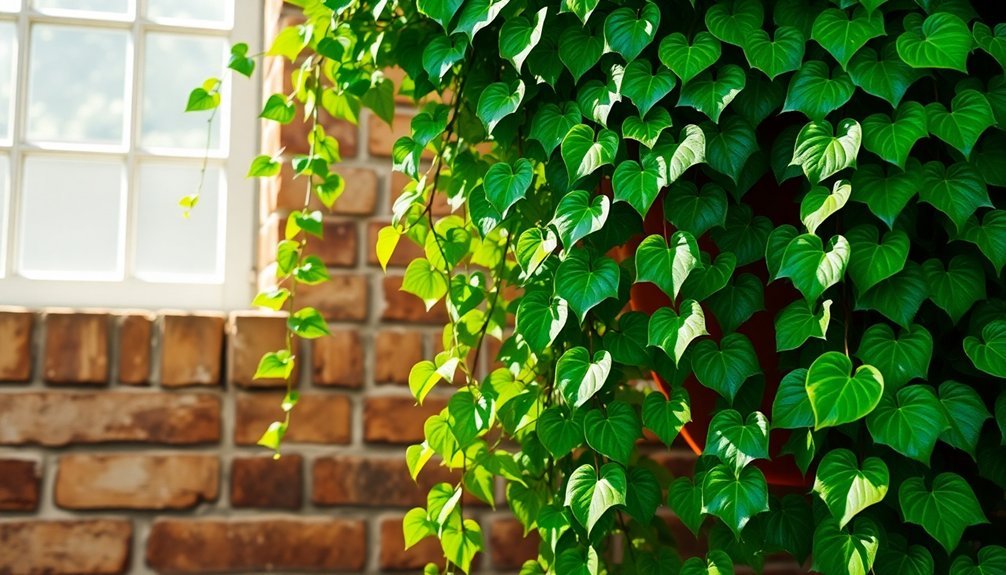
Despite its reputation as a classic wall-climbing plant, English Ivy serves a remarkable dual purpose as your indoor humidity manager.
You'll find it thrives best in humidity levels between 40% and 60%, making it an excellent choice for naturally regulating your home's moisture levels.
Watch your ivy closely – it'll tell you when humidity isn't right. Brown edges and wilting leaves signal it's too dry, while yellowing leaves and mushy stems indicate excess moisture.
To maintain the sweet spot, try misting your ivy, using a pebble tray, or grouping it with other plants. If you're looking for a more hands-off approach, place it in naturally humid spaces like your bathroom or kitchen.
For an added bonus, ivy can help cool your home, reducing wall temperatures and managing indoor humidity levels naturally. Research shows it can reduce wall temperature by 7.2°C when used as wall coverage.
Bamboo Palm: Tropical Elegance Meets Moisture Control
As graceful as its name suggests, the Bamboo Palm brings both tropical sophistication and natural humidity control to your indoor space.
You'll love how its elegant fronds create a lush, tropical ambiance while effectively absorbing excess moisture and purifying your air.
This compact beauty thrives in partial shade and temperatures between 65-80°F, making it perfect for your bathroom, kitchen, or basement.
You'll need to keep the soil consistently moist but not waterlogged, and provide regular misting during dry winter months.
The palm's natural resistance to pests means less maintenance for you.
Place your Bamboo Palm in areas prone to humidity issues, and you'll enjoy both its air-purifying benefits and its ability to regulate moisture levels through transpiration.
Remember to fertilize during spring and summer for ideal growth.
Cast Iron Plant: The Resilient Humidity Warrior
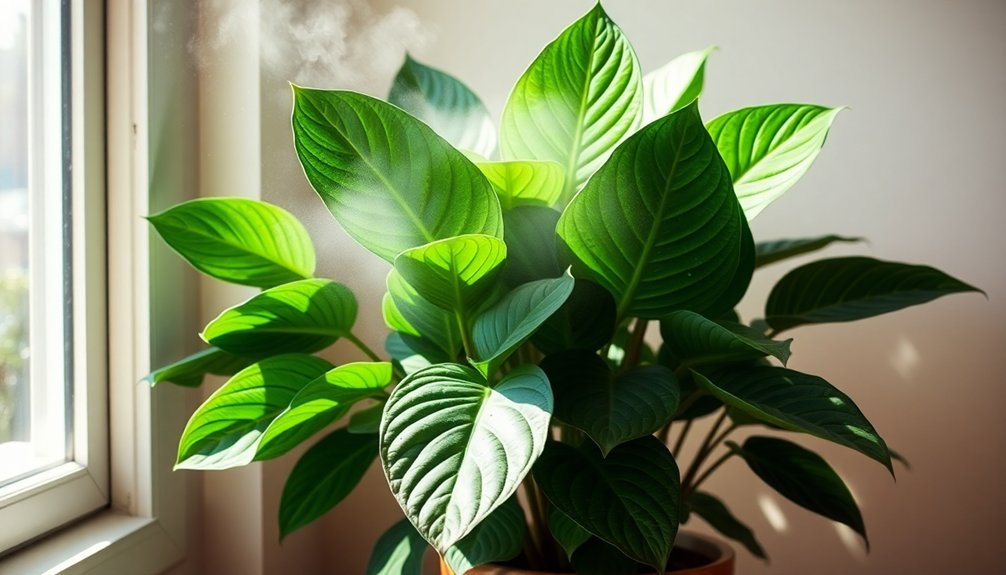
You'll find the Cast Iron Plant living up to its name with remarkable adaptability to various humidity levels and growing conditions.
This sturdy performer can thrive in low-light areas while maintaining consistent growth patterns, even when room moisture fluctuates between 40-60%.
Whether you're dealing with dry winter air or humid summer conditions, your Cast Iron Plant will steadily grow without demanding the precise humidity control that many other indoor plants require.
Adaptable Growth Patterns
The Cast Iron Plant's remarkable adaptability makes it a champion at managing varying humidity levels. You'll find this plant thrives in both dry and humid conditions, maintaining its sturdy growth pattern regardless of environmental changes.
| Growth Factor | Response Pattern |
|---|---|
| Low Humidity | Slows growth, maintains health |
| High Humidity | Accelerates leaf production |
| Temperature Shifts | Adjusts growth rate naturally |
| Seasonal Changes | Maintains evergreen presence |
While it prefers humidity between 40-60%, your Cast Iron Plant won't suffer if levels fluctuate. Its thick, leathery leaves help retain moisture during dry spells, and its robust root system adapts to varying water conditions. You can support its growth by grouping it with other plants or using a humidity tray, though it'll survive just fine without these extras.
Low-Light Humidity Performance
Building on its adaptable nature, Cast Iron Plants truly shine in low-light conditions while maintaining impressive humidity control.
You'll find these resilient plants thrive in humidity levels between 40% and 60%, making them perfect for challenging indoor spaces.
When you're dealing with less-than-ideal lighting, you can still maintain ideal humidity by placing a pebble tray nearby or grouping your Cast Iron Plant with other moisture-loving varieties.
If you notice brown leaf tips or slow growth, it's time to boost humidity levels. You can easily accomplish this with a humidifier or light misting.
Keep your plant's environment between 60°F and 75°F, and remember that proper air circulation is essential.
While they're forgiving in low light, you'll want to monitor humidity more closely in darker spaces to prevent potential issues with pests or diseases.
Lucky Bamboo: Stylish Moisture Management
Despite its delicate appearance, Lucky Bamboo thrives as a stylish humidity-balancing plant that perfectly mimics its tropical rainforest origins.
You'll find it performs best in environments with 40%-60% humidity, which you can easily maintain through regular misting or a pebble tray setup.
To keep your Lucky Bamboo healthy, place it in indirect light and maintain temperatures between 65°F-90°F.
You'll want to use distilled or filtered water, as it's sensitive to chemicals found in tap water.
Don't forget to monitor humidity levels with a hygrometer to prevent issues like leaf yellowing or fungal growth.
If you notice any problems, adjust your care routine accordingly.
Too little humidity causes wilting, while excess moisture without proper drainage leads to root rot.
With proper maintenance, you'll enjoy this elegant plant's humidity-balancing benefits year-round.
Spider Plant: The Multi-Talented Humidity Expert
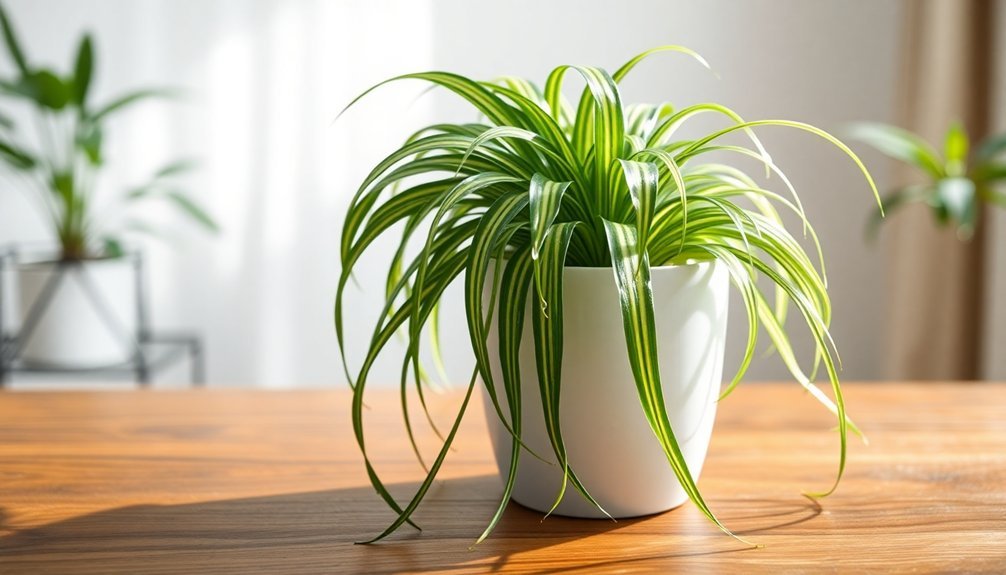
You'll find spider plants are remarkably easy to grow, thriving in bright indirect light while tolerating various indoor conditions between 65-75°F.
Your spider plant will help create a healthier home environment by absorbing excess moisture and filtering out harmful toxins like formaldehyde and carbon monoxide.
To keep your plant healthy and multiplying, allow the top inch of soil to dry between waterings and consider propagating the spiderettes to expand your collection.
Growing Spider Plants Successfully
The spider plant stands as one of the most adaptable and forgiving houseplants you'll encounter, making it perfect for both novice and experienced gardeners.
You'll get the best results by placing your spider plant in bright indirect light, as direct sun can scorch its distinctive leaves. Keep the temperature between 60-80°F and maintain humidity around 50-60% through misting or a humidifier.
Watch for leaf tips – crispy ones signal underwatering, while dark brown tips indicate overwatering.
Plant in well-draining potting soil and water when the top half becomes dry. During growing season, feed monthly with all-purpose fertilizer.
Don't rush to repot; spider plants actually thrive when slightly root-bound. If you're dealing with tap water, consider switching to distilled or rainwater to prevent brown leaf tips.
Spider Plant Health Benefits
Beyond its easy-care nature, spider plants offer remarkable health benefits that make them outstanding additions to any indoor space. You'll breathe easier knowing these plants effectively remove harmful chemicals like formaldehyde, xylene, and carbon monoxide from your indoor air. NASA ranks them among the top 3 houseplants for air purification.
| Benefit Category | Impact | Key Feature |
|---|---|---|
| Air Quality | Removes toxins | NASA-approved purifier |
| Health Support | Speeds recovery | Reduces pain medication needs |
| Safety Profile | ASPCA-certified | Safe for pets and children |
These natural humidifiers create therapeutic environments that can help reduce anxiety, improve concentration, and boost your overall well-being. Whether you're recovering from surgery or simply want a healthier home, spider plants work tirelessly to maintain balanced humidity levels while fighting airborne illnesses.
Orchids: Exotic Moisture Masters
Despite their reputation for being finicky, orchids serve as natural humidity regulators when grown indoors, thriving in environments with 40-70% moisture levels.
They'll help maintain balanced moisture in your home while adding exotic beauty to your space.
You'll get the best results by grouping orchids with other plants to create a moisture-rich microclimate.
While you might be tempted to mist your orchids frequently, it's more effective to use a quality humidifier that can distribute several quarts of water per hour into the air.
Watch out for excess moisture, though – humidity above 70% needs proper air circulation to prevent fungal growth.
Different orchid varieties have varying needs: Phalaenopsis adapts well to home environments, while thin-leafed species demand higher humidity.
In well-balanced conditions, you'll water less frequently as these exotic beauties naturally regulate their moisture intake.
Air Plants: Natural Humidity Regulators
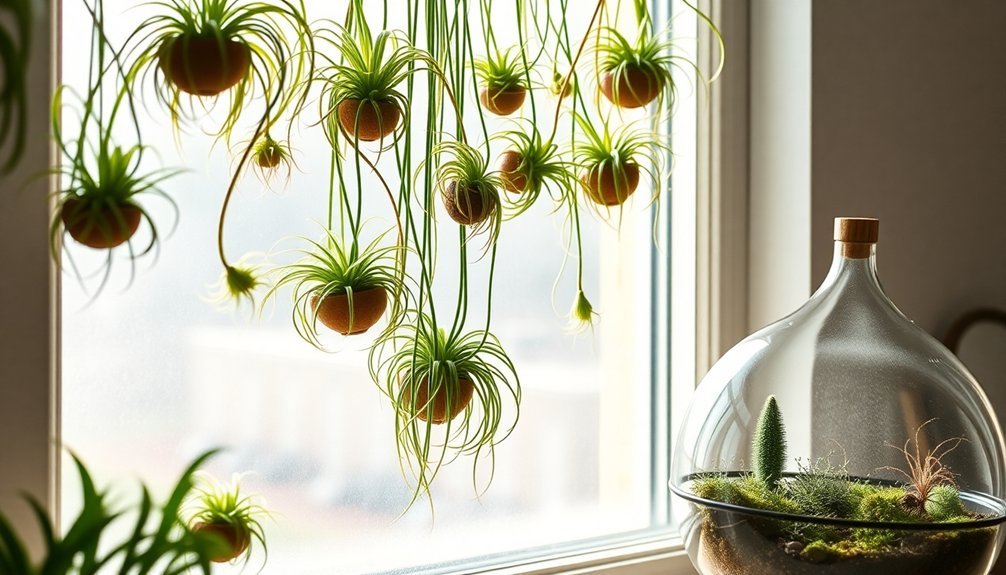
Much like their orchid cousins, air plants demonstrate remarkable humidity-regulating capabilities without needing any soil. You'll find these unique members of the bromeliad family absorbing moisture and nutrients directly through their leaves, making them perfect for managing humid spaces.
You can mount these versatile plants on driftwood or display them in terrariums where they'll thrive in filtered sunlight. To keep them healthy, soak them weekly for 20-30 minutes and maintain temperatures between 65-80°F.
They'll help you combat excess moisture while filtering dust and airborne pollutants from your home.
Beyond their practical benefits, you won't need to fuss with fertilizers or complicated care routines. They'll naturally prevent mold and mildew issues while adding an exotic touch to your space through their ornamental appeal.
Calathea: The Sensitive Moisture Monitor
If you're looking for a plant that acts as a natural humidity gauge, you'll find Calathea's leaf movements fascinating as they open in humid conditions and close when the air becomes too dry.
Your Calathea will thrive best with humidity levels above 60%, which you can achieve through a humidifier or humidity tray placement.
While these tropical beauties prefer bright indirect light, they'll communicate their moisture needs through their leaves, making them excellent indicators of your home's humidity levels.
Calathea's Humidity Sweet Spot
While many houseplants can tolerate varying moisture levels, Calathea stands out as nature's own humidity gauge. You'll need to maintain humidity between 50-60% to keep your Calathea thriving, as it's particularly sensitive to moisture fluctuations in the air.
Watch for warning signs that your Calathea isn't getting enough humidity – crispy brown edges, curling leaves, or drooping foliage are clear indicators.
You can boost moisture levels by placing a pebble tray under the pot, using a humidifier with distilled water, or grouping it with other plants to create a moisture-rich microclimate. If you've got a steamy bathroom with good light, your Calathea will love it there.
Proper humidity not only prevents leaf damage but also helps your plant absorb nutrients more effectively.
Light and Moisture Needs
Despite their reputation for being fussy plants, Calatheas can thrive in your home when you understand their specific light requirements. You'll want to place them in bright, indirect light, ideally near a north- or east-facing window. If you notice fading leaves or crispy edges, you're likely giving them too much direct sun.
| Light Condition | Signs to Watch | Quick Fix |
|---|---|---|
| Too Bright | Faded colors, burns | Add sheer curtains |
| Ideal | Vibrant leaves, active movement | Keep it there! |
| Too Dark | Yellow leaves, leggy growth | Add grow lights |
| Seasonal Changes | Slower growth, dull patterns | Adjust location |
During winter months, you might need to supplement with grow lights to maintain optimal growth. Remember to rotate your plant regularly for even growth, and keep it away from heating vents that could compromise its moisture levels.
Thriving Through Leaf Signals
Your Calathea's leaves serve as a sophisticated monitoring system, sending clear signals about its moisture needs.
When you notice yellowing leaves or wilting despite damp soil, your plant's telling you it's getting too much water. Don't be fooled by wilting alone, as it can mimic underwatering symptoms.
Check the soil with your finger before watering – if the top inch feels wet, wait. You'll want to maintain proper humidity through misting or humidifiers rather than increasing watering frequency.
Pay attention to any foul odors from the soil, as this indicates root rot from overwatering. To keep your Calathea thriving, use well-draining pots and adjust your watering schedule seasonally.
Frequently Asked Questions
Can Humidity-Absorbing Plants Trigger Allergies or Respiratory Issues?
Yes, humidity-absorbing plants can trigger your allergies through pollen, mold in overwatered soil, dust on leaves, and plant sap. You'll need proper care and ventilation to minimize these potential respiratory issues.
How Often Should Humidity-Absorbing Plants Be Rotated to Different Room Locations?
You should rotate your humidity-absorbing plants every 1-2 weeks, depending on your home's moisture levels. Monitor plant health and adjust rotation frequency based on seasonal changes and individual room humidity conditions.
Do These Plants Attract More Insects Than Regular Houseplants?
You'll notice that humidity-loving plants can attract more insects than regular houseplants, especially if they're stressed or poorly maintained. However, with proper care and ventilation, they won't necessarily draw more pests.
What's the Ideal Distance Between Multiple Humidity-Absorbing Plants?
You'll want to space humidity-absorbing plants 2-3 feet apart. While they can be closer to create microenvironments, don't crowd them. This spacing lets them share humidity benefits while maintaining proper airflow.
Can These Plants Effectively Reduce Bathroom Mold Growth?
Yes, you'll find these plants can considerably reduce bathroom mold growth. Place humidity-absorbing plants like Peace Lilies, Boston Ferns, or English Ivy near moisture-prone areas, and they'll help prevent mold by regulating humidity levels.
In Summary
Whether you're battling dry indoor air or excess moisture, these top humidity-balancing plants will transform your space naturally. You'll find that incorporating just one or two of these leafy allies can make a noticeable difference in your home's comfort level. Remember to match your plant choice with your specific needs and care capabilities, and you'll enjoy the perfect moisture balance year-round.

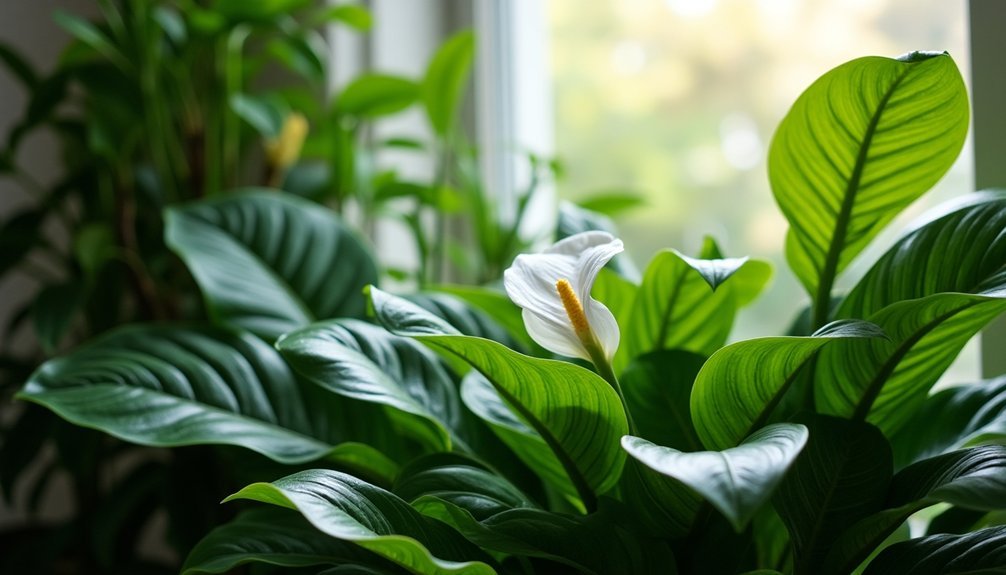



Leave a Reply